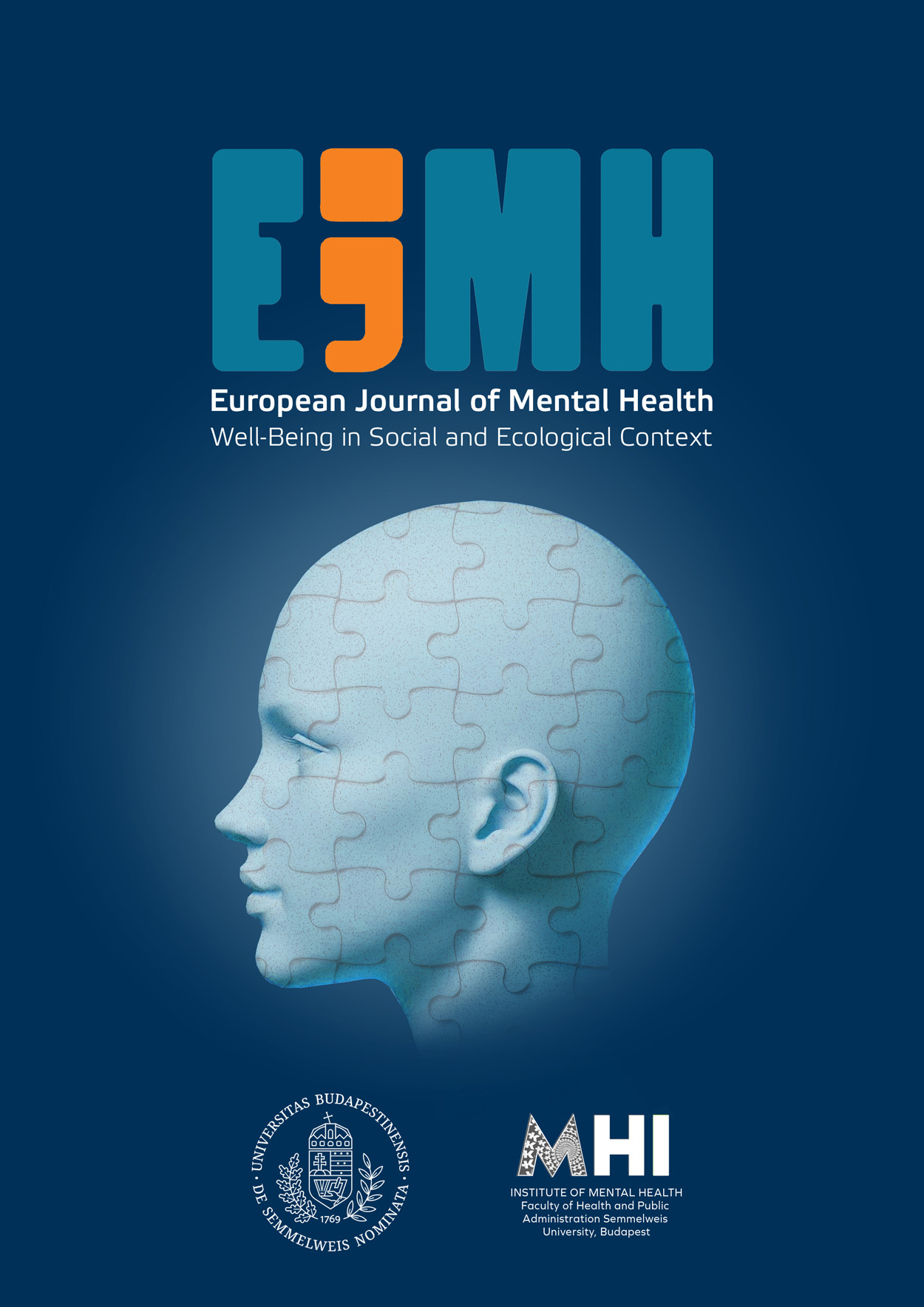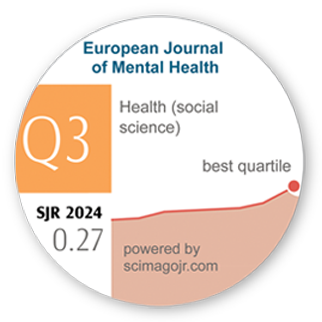Factor Structure of the Shortened Six-Item Version of the de Jong Gierveld Loneliness Scale (DJGLS-6). A Systematic Review and Testing Factor Models in a Nationally Representative Sample
DOI:
https://doi.org/10.5708/EJMH.18.2023.0001Keywords:
loneliness, systematic review, factor structure, confirmatory factor analysis, de Jong Gierveld scale for lonelinessAbstract
Introduction: Loneliness is linked to negative physical and mental health outcomes. Therefore, it is important to employ reliable and valid screening measures for early detection and treatment. A widely used scale for assessing loneliness is the shortened six-item Jong Gierveld Loneliness Scale (DJGLS-6).
Aims: To review and evaluate the factor structure of the DJGLS-6.
Methods: Study 1 was a systematic review. To examine the factor structure of the DJGLS-6, peer-reviewed studies were reviewed in accordance with PRISMA guidelines. Study 2 tested the factor analytic models found in Study 1. Confirmatory factor analysis (CFA) was performed using data from a nationally representative sample of adults to assess the latent structure of the six-item scale.
Results: In Study 1, findings from the two papers reviewed suggested that the scale measures two correlated dimensions: social and emotional loneliness. This finding was consistent with the results of Study 2. However, the fit statistics for the one and two-factor CFA models were not acceptable. Modification indices indicated that adding a cross-factor loading to allow item 2 (“I miss having people around”) of the social loneliness factor, to load on both the emotional and social factor, to load on both the emotional and social factors would significantly improve the fit of the model.
Conclusions: The analysis failed to support previous findings concerning the robustness of the subscales. We recommend performing future evaluations of the scale and for the authors to consider changing item 2 accordingly.
References
Asparouhov, T., & Muthén, B. (2012). Using Mplus TECH11 and TECH14 to test the number of latent classes. Mplus Web Notes, 14(22), 1–19.
http://www.statmodel.com/examples/webnotes/webnote14.pdf
Amarat, M., Akbolat, M., Ünal, Ö., & Güneş Karakaya, B. (2019). The mediating role of work alienation in the effect of workplace loneliness on nurses’ performance. Journal of Nursing Management, 27(3), 553–559.
https://doi.org/10.1111/jonm.12710
Bentler, P. M. (1990). Comparative Fit Indexes in Structural Models. Psychological Bulletin, 107(2), 238–246.
https://psycnet.apa.org/doi/10.1037/0033-2909.107.2.238
Boss, L., Kang, D. H., & Branson, S. (2015). Loneliness and cognitive function in the older adult: a systematic review. International Psychogeriatrics, 27(4), 541–553.
https://doi.org/10.1017/s1041610214002749
Chang, E. C., Martos, T., Sallay, V., Chang, O. D., Wright, K. M., Najarian, A.S.-M., & Lee, J. (2017). Examining optimism and hope as protective factors of suicide risk in Hungarian college students: Is risk highest among those lacking positive psychological protection? Cognitive Therapy and Research, 41(2), 278–288.
https://doi.org/10.1007/s10608-016-9810-0
Cloitre, M., Hyland, P., Bisson, J. I., Brewin, C. R., Roberts, N. P., Karatzias, T., & Shevlin, M. (2019). ICD‐11 posttraumatic stress disorder and complex posttraumatic stress disorder in the United States: A population‐based study. Journal of Traumatic Stress, 32(6), 833–842.
https://doi.org/10.1002/jts.22454
Cortina, J. M. (1993). What is coefficient alpha? An examination of theory and applications. Journal of Applied Psychology, 78(1), 98–104.
https://doi.org/10.1037/0021-9010.78.1.98
Danneel, S., Bijttebier, P., Bastin, M., Colpin, H., Van den Noortgate, W., Van Leeuwen, K., & Goossens, L. (2019). Loneliness, social anxiety, and depressive symptoms in adolescence: Examining their distinctiveness through factor analysis. Journal of Child and Family Studies, 28(5), 1326–1336.
https://doi.org/10.1007/s10826-019-01354-3
De Jong Gierveld, J., & Kamphuis, F. (1985). The Development of a Rasch-Type Loneliness Scale. Applied Psychological Measurement, 9(3), 289–299.
https://doi.org/10.1177/014662168500900307
De Jong Gierveld, J., & Van Tilburg T. G. (1999). Manual of the loneliness scale. VU University, Amsterdam.
De Jong Gierveld, J., & Van Tilburg, T. G. (2006). A six-item scale for overall, emotional and social loneliness: confirmatory tests on survey data. Research on Aging, 28(5), 582–598.
https://doi.org/10.1177/0164027506289723
De Jong Gierveld, J., & Van Tilburg, T. G. (2010). The de Jong Gierveld short scales for emotional and social loneliness: tested on data from 7 countries in the UN generations and gender surveys. European Journal of Ageing, 7(2), 121–130.
https://doi.org/10.1007/s10433-010-0144-6
Dykstra, P. A. (2009). Older adult loneliness: Myths and realities. European Journal of Ageing, 6(2), 91–100.
https://doi.org/10.1007/s10433-009-0110-3
Dykstra, P. A., & de Jong Gierveld, J. (2004). Gender and marital-history differences in emotional and social loneliness among Dutch older adults. Canadian Journal on Aging, 23(2), 141–155.
https://doi.org/10.1353/cja.2004.0018
Goldsmith, S. K., Pellmar T. C., Kleinman A. M., & Bunney W. E. (Eds) (2002). Reducing suicide: A national imperative. National Academies Press.
https://doi.org/10.17226/10398
Hawkley, L. C., & Cacioppo, J. T. (2010). Loneliness Matters: A Theoretical and Empirical Review of Consequences and Mechanisms. Annals of Behavioral Medicine, (40)2, 218–227.
https://doi.org/10.1007/s12160-010-9210-8
Hawkley, L. C., Thisted, R. A., Masi, C. M., & Cacioppo, J. T. (2010). Loneliness predicts increased blood pressure: 5-year cross-lagged analyses in middle-aged and older adults. Psychology and Aging, 25(1), 132–141.
https://doi.org/10.1037/a0017805
Jackson, D. L., Gillaspy, J. A., & Purc-Stephenson, R. (2009). Reporting practices in confirmatory factor analysis: an overview and some recommendations. Psychological Methods, 14(1), 6–23.
https://doi.org/10.1037/a0014694
Jaafar, M. H., Villiers‐Tuthill, A., Lim, M. A., Ragunathan, D., & Morgan, K. (2020). Validation of the Malay version of the de Jong Gierveld loneliness scale. Australasian Journal on Ageing, 39(1), e9–e15.
https://doi.org/10.1111/ajag.12672
Knipscheer, C. P. M., de Jong Gierveld, J, G. van Tilburg, T. & Dykstra, P. A. (1995). Living Arrangements and Social Networks of Older Adults. University Press: Amsterdam University.
Leung, G. T. Y., de Jong Gierveld, J., & Lam, L. C. W. (2008). Validation of the Chinese translation of the 6-item de Jong Gierveld Loneliness Scale in elderly Chinese. International Psychogeriatrics, 20(6), 1262–1272.
https://doi.org/10.1017/s1041610208007552
Liberati, A., Altman, D. G., Tetzlaff, J., Mulrow, C., Gøtzsche, P. C., Ioannidis, J. P. A., Clarke, M., Devereaux, P. J., Kleijnen, J., & Moher, D. (2009). The PRISMA statement for reporting systematic reviews and meta-analyses of studies that evaluate health care interventions: explanation and elaboration. Journal of Clinical Epidemiology, 62(10), e1–e34.
https://doi.org/10.1016/j.jclinepi.2009.06.006
Liu, L., Gou, Z., & Zuo, J. (2016). Social support mediates loneliness and depression in elderly people. Journal of Health Psychology, 21(5), 750–758.
https://doi.org/10.1177/1359105314536941
McCutchen, C., Hyland, P., Shevlin, M., & Cloitre, M. (2022). The occurrence and co-occurrence of ACEs and their relationship to mental health in the United States and Ireland. Child Abuse & Neglect, 129, Article 105681.
https://doi.org/10.1016/j.chiabu.2022.105681
Nunnally, J. C. (1978). Psychometric theory (2nd ed.). McGraw-Hill.
Steiger, J. H. (1990). Structural model evaluation and modification: An interval estimation approach. Multivariate Behavioral Research, 25(2), 173–180.
https://doi.org/10.1207/s15327906mbr2502_4
Tanaka, J. S. (1987). “How big is big enough?”: Sample size and goodness of fit in structural equation models with latent variables. Child Development, 58(1), 134–146.
https://doi.org/10.2307/1130296
Taylor, B., Wyle, E., Dempster, M., & Donnelly, M. (2007). Systematically retrieving research: A case study evaluating seven databases. Research on Social Work Practice, 17(6), 697–706.
http://dx.doi.org/10.1177/1049731507304402
Thurston, R. C., & Kubzansky, L. D. (2009). Women, loneliness, and incident coronary heart disease. Psychosomatic Medicine, 71(8), 836–842.
https://doi.org/10.1097/psy.0b013e3181b40efc
Tucker, L. R., & Lewis, C. (1973). The reliability coefficient for maximum likelihood factor analysis. Psychometrika, 38,1–10.
https://doi.org/10.1007/BF02291170
VanderWeele, T. J., Hawkley, L. C., & Cacioppo, J. T. (2012). On the reciprocal association between loneliness and subjective well-being. American Journal of Epidemiology, 176(9), 777–784.
https://doi.org/10.1093/aje/kws173
Weiss, R. S., (1973) Loneliness: the experience of emotional and social isolation. MIT Press.






